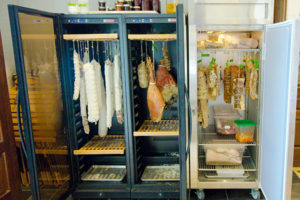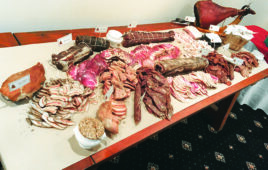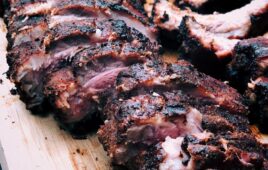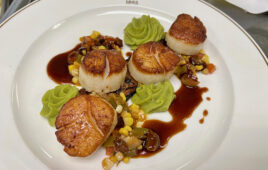While the most basic types are pretty simple, others like coppa salami or fermented sausages can be lethal if not made correctly.
It used to be a big deal if a chef made his or her own salami. But charcuterie and salumi have come a long way, and in line with the trend to local sourcing, a growing number of club and resort properties are now featuring their own house-made cured meats.
At Hageman Reserve, a new outdoors-oriented private club in Sulphur Bluff, Texas (“The Bold New Club Concept at Hageman Reserve,” C&RB, March 2016), Executive Chef Mike Gibson has between ten and 25 different kinds of cured meats available at any given time.
“Our boards usually feature six or eight different meats, ranging from lonza and pancetta to prociutto and sopressata,” says Gibson, who plates the meats with house-made pickles as well as house-made bread. “Members don’t always know what meats we feature, but they always love that we make them all in-house.”
Hageman Reserve’s charcuterie and salumi program started with Gibson, who came to the club in September after working primarily in Dallas-area restaurants. At one—Lucia—he studied under charcuterie master David Uygur, who taught him mostly everything he knows about curing meats.
“We went through a lot of product, so we were breaking down whole pigs every two weeks,” says Gibson. “When I came to Hageman—where we raise our own wagyu beef on property—it seemed like an obvious thing to start up.”
Gibson began by searching for a supplier of heritage-breed pigs. With the help of a member, he was able to find a farmer who raises small herds of Red Wattle hogs that feed on acorns and pecans in open pastures. (Gibson prefers Red Wattle for how it yields deep red cuts interlaced with rich veins of fat.)
“We wanted the pigs to have a little more fat on them, so we started taking the leftover corn from our property and giving it to the farmer, who feeds it to the pigs to get them up to the desired weight,” says Gibson. “We get one hog each month and it arrives split in half. I spend a couple hours breaking it down, curing it and getting it ready for the aging process.”
While the breakdown only takes a couple of hours, the curing process takes anywhere from a couple of weeks for pancetta to between 18 months and two years for prociutto. Gibson also makes fresh sausages, pâté and mousses that are ready in far shorter timeframes—often just days.
“There’s a sense of pride in knowing that our meats are all house-made,” says Gibson, who hangs the meats in a wine cabinet that he converted into a curing chamber and aptly renamed the Salumi Cave. “It has glass doors, so you can see the sausages with the mold and you can see all the prociutto,” he says. “It’s right near the chef’s table, too.”
Michigan-Made Meats
Nearly 1,000 miles north of Hageman Reserve in Richland, Mich., Gull Lake Country Club also offers its nearly 490 members a variety of cured meats prepared by Executive Chef Adam Stacey, who has been with the club for two years.
“We usually have two different kinds available at any one time,” says Stacey, who changes menus every couple of weeks to feature the different cured products he creates.
Getting a charcuterie program off the ground can be time-consuming, Stacey notes, because of the requirement of creating a Standard Operating Procedure for the health department. “It takes a lot of time, but it’s still profitable for us,” he says.
“It’s a lot of fun to make your own sausage and it’s not something just anyone can do,” Stacey adds. “These types of programs help to set you apart—and make your dining operation that much more special.”
At Hageman Reserve, Gibson’s favorite salumi to make is ‘nduja, a cured spicy spreadable salumi originally from Calabria, Italy.
“The biggest challenges are space and keeping enough on hand to meet demand,” says Gibson. “When you’re out, you’re out. It isn’t something you can quickly recreate.”
Gibson agrees with Stacey about the initial challenges involved with starting a charcturie program. “You have to be very careful with your starter cultures and check pH levels to make sure what you’re making is safe,” he says. “But once you find a rhythm, it’s just like anything else. It’s part of our brand. It sets us apart.”
For both Hageman Reserve and Gull Lake CC, cured meats aren’t relegated to charcuterie boards. Gibson uses things like lardo and pancetta in dozens of other applications. They are also featured during the club’s nightly cocktail hour as well as for special events, where a carving station will be set up to cut meats to order.
Gull Lake also features cured meats, including summer sausages, pepperoni, and pork belly, in a variety of menu applications.




